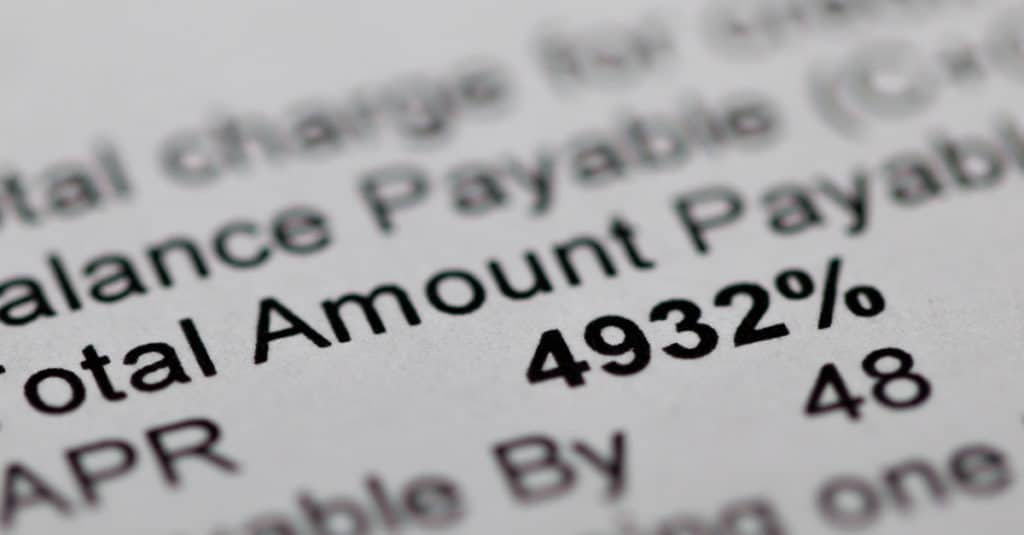As many Americans suffer financially through the lingering COVID-19 pandemic, it’s a good time to be a payday lender, particularly in the South, where cities have the highest numbers of payday loan storefronts in the U.S., and residents are doing a lot of complaining to the Consumer Financial Protection Bureau.
DebtHammer compared data from U.S. cities with populations of 500,000 or more to find the top cities with the worst payday lending problems. Rankings were compiled by comparing stores per capita, internet search volumes, loan rollover numbers, interest rates and maximum loan amounts.
Memphis, Tenn., tops the list, one of three Tennessee cities to make the Top 10. Jackson, Miss., Las Vegas, Baton Rouge, La., and New Orleans round out the top five.
Key takeaways:
- Payday loans are a bigger problem in the South: Six states — Tennessee, Mississippi, Nevada, Louisiana, Texas and Mississippi — are represented in the Top 10. Five of those are in the South — Nevada is the outlier. The likely reason: a high number of unbanked residents. All of the states on the list except Nevada have an unbanked population of 7.1% or higher.
- Betting on borrowers: All of the top five cities are located less than 50 miles from a casino. Gambling is a $110 billion industry in the U.S., and lenders are often available onsite. As many as 23 million Americans go into debt because of gambling, with the average loss estimated at around $55,000.
- In Tennessee, you can place a bet and get a loan at the same spot: Tennessee is the only state with three cities in the Top 10, and one unique factor: It’s possible for Tennessee bettors to get a loan and place a bet under the same roof.
Table of contents
The 10 cities with the worst payday lending problems
1.) Memphis, Tennessee
The unofficial capital of the mid-South – and the worst city overall for payday loans — is home to Beale Street, Graceland and some top-notch barbecue, but it’s also home to more than its fair share of payday lenders.
Before three of the state’s cities made DebtHammer’s list, Tennessee already had its share of problems with payday loans. According to a 2017 study from Metro Ideas Project, Tennessee has the most predatory lenders in the country. Shelby County led with 232 brick-and-mortar predatory lending locations. Shelby County also happens to be home to Memphis, the city DebtHammer found to be the worst city in the U.S. for payday loans.
According to Bank On Memphis data, 40% of the Memphis area is unbanked or underbanked. That’s roughly 90,000 unbanked and 120,000 underbanked families.
Tennessee also holds the dubious honor as the state where the payday loan industry was born. Allan Jones, the “father of the payday loan industry,” founded Check Into Cash, believed to be the first-ever payday loan company, in 1993 in Cleveland, Tenn. Since then, Check Into Cash has become a billion-dollar-a-year enterprise and the third-largest payday lending company in the U.S.
Across the region, there are 430 payday loan stores – or 31.78 per capita — with a maximum interest rate of 460%. The region’s poverty rate is 17% and the median household income is $54,859. The median age is 36. The population is 1,353,158. Memphis residents are 47% Black or African American, 42% non-Hispanic white and 3% Hispanic white.
2.) Jackson, Mississippi
Jackson residents are tops in the nation for number of brick-and-mortar payday loan storefronts, according to our findings.
In Jackson, 17.2% of households are unbanked, and 17.8% are underbanked.
Mississippi was one of the few states that saw legislation become law this spring when the governor signed HB 1075, which made some changes to the state’s already-existing Credit Availability Act, Title Pledge Act, and Check Cashers Act.
Mississippi’s state capital has an average household income of $52,426 and a 17% poverty rate. The median age is 37. The area has 219 payday loan stores, or 33.37 per capita, with a maximum interest rate of 521%. The population is 594,800. Jackson’s residents are 49% Black or African American and 45% white.
3.) Las Vegas, Nevada
The self-proclaimed entertainment capital of the world is also the No. 1 city for complaints to the Consumer Financial Protection Bureau about payday lenders.
About 10% of Las Vegas-area households are unbanked, and 29% are underbanked.
The poverty rate is 13% with a median household income of $62,107. The median age is 37. There are 482 stores – 21.97 per capita – offering payday loans, with a maximum interest rate of 652%. The population is 2.27 million. Sin City’s residents are 41% non-Hispanic white, 18% Hispanic white and 12% Black or African-American.
4.) Baton Rouge, Louisiana
Louisiana’s capital is the state’s second-largest city, but it’s tops in the U.S. for Google Trends search volume for “payday loans.”
Roughly 10.8% of Baton Rouge residents are unbanked, and another 16.5% are underbanked
The poverty rate is 24% and the median household income is $44,470. The median age is 31. There are 157 payday loan stores within the metropolitan area, or 19.75 per capita, with a maximum interest rate of 391%. The population is 794,838. The majority of residents – 54% – are Black or African American, with 36% non-Hispanic white.
5.) New Orleans, Louisiana
The most populous city in Louisiana, the Big Easy’s mantra is “laissez les bon temps rouler,” or “Let the good times roll.” But the city isn’t very laid back about payday lending. It ranks No. 2 in the U.S. for Google Trends search volume for “payday loans.”
In New Orleans, about 17.4% of the city’s residents are unbanked, and 16.5% are underbanked.
The poverty rate is 23% and the median household income is $45,615. The median age is 38. The population is 1,422,827. There are 122 stores offering payday loans, or 19.33 per capita, with a maximum interest rate of 391%. New Orleans residents are 58% Black or African American, 30% non-Hispanic white and 3% Hispanic white.
6.) Nashville, Tennessee
Music City racks up its fair share of CFPB complaints about payday lenders, coming in at No. 4. The city is also No. 4 for number of brick-and-mortar payday loan storefronts.
About 6.5% of Nashville residents are unbanked, and another 18.7% are underbanked.
Nashville’s poverty rate is 11.4% and the median household income is $70,262. The median age is 36. The population is 1.93 million. There are 547 stores offering payday loans, or 30.56 per capita, with a maximum interest rate of 460%. Nashville residents are 71% non-Hispanic white, 15% Black or African American and 5% Hispanic white.
7.) Chattanooga, Tennessee
Chattanooga comes in as the No. 2 city for most payday loan storefronts. Only Jackson has more.
Chattanooga’s poverty rate is 13% and the median household income is $55,366. The median age is 40. The population is 566,153. There are 305 stores offering payday loans, or 33.18 per capita, with a maximum interest rate of 460%. Chattanooga residents are 80% non-Hispanic White, 13% Black or African American and 3% Hispanic white.
8.) Dallas-Fort Worth, Texas
Dallas may only be Texas’ third-largest city, but the Dallas-Fort Worth metropolitan area is No. 5 in the U.S. for CFPB complaints about payday lenders. Dallas and Houston both rank No. 1 for maximum payday loan amount.
About 6.5% of Dallas-Fort Worth residents are unbanked, and another 18.7% are underbanked.
The poverty rate is about 11% and the median household income averages out to about $72,765. The median age is 35. The population is 7.57 million. There are 1,127 stores offering payday loans — or 16.43 per capita — across North Texas, with a maximum interest rate of 662%. The population is 6,857,959. The area’s residents are 44% non-Hispanic white, 22% Hispanic white and 16% Black or African American.
9.) Houston, Texas
Texas’ most populous city is the fourth largest in the U.S., and has the No. 10 highest number of payday loan storefronts in the country.
In the Houston area, 11.8% of residents are unbanked, and 22.4% are underbanked, according to a report from the Kinder Institute for Urban Research at Rice University.
The poverty rate is 20% and the median household income is 52,450. The median age is 33. The population is 2.32 million. There are 1,137 stores offering payday loans — or 18.57 per capita — across the area, with a maximum interest rate of 662%. Residents are 31% Hispanic white, 23% non-Hispanic white and 22% Black or African-American.
10.) Birmingham, Alabama
The Birmingham-Hoover metropolitan area is the most populous in Alabama, but it’s also the city with the sixth-highest number of payday lending storefronts, and its No. 7 in Google Trends search volume for “payday loans.”
In Birmingham, about 6.5% of residents are unbanked, and 18.7% are underbanked.
The poverty rate is 14% and the median household income is $58,366. The median age is 38. There are 295 payday loan stores within the metropolitan area, or 22.34 per capita, with a maximum interest rate of 456%. The population is 1.09 million. Residents are 61% non-Hispanic white, 30% Black and 2% white Hispanic.

Full rankings: Cities with the worst payday lending problems
The professors weigh in

Dr. Robert H. Scott III
Professor, Department of Economics, Finance and Real Estate, Monmouth University
In your opinion, what’s the biggest financial challenge Americans are currently facing?
I think it is important for people to prioritize savings. Research shows that even saving a small amount on a regular basis has a tremendous impact on financial stability.

Dr. Jason Beck
Associate Professor of Economics, Parker College of Business, Georgia Southern University Armstrong Campus
In your opinion, what are some of the common factors that land these cities at the top of the list?
They probably have a large unbanked population, which these payday loan operations appear to target.
Payday lenders were categorized as “essential businesses” during the COVID-19 shutdowns. How do you think these lenders are capitalizing on borrowers as the pandemic stretches on?
Anytime you see economic distress, payday loan businesses pick up. It’s a countercyclical industry. As savings are drawn down, the odds of living paycheck to paycheck increase. The next step in that progression is the payday loan.

Dr. Alexander Brown
Professor, Department of Economics, Texas A&M University
What advice would you give to anyone who is considering taking out a payday loan?
The first thing to recognize is that the real dangers of the payday loan are recurring use: When an individual is borrowing at an absurdly high rate of interest for a long period of time (e.g., let’s say a year), it destroys any possibility of wealth accumulation. While a single use may not be so harmful in itself, for various reasons, individuals appear to get ensnared after using once and repeatedly going back to payday loans. It’s likely the case people are overconfident about their ability to use once and stop rather than becoming a repeat borrower. I would advise people to look for other ways to make payments, from getting short-term funds and resources from family members to talking with creditors before bills are due to restructure or postpone payments. If one must use a payday loan, monitoring is key; one should write down every loan and the finance cost to see just how much money is being spent on the payday loan.
What role will new technology play — including online banking apps and peer-to-peer lending platforms — in eventually rendering payday lenders obsolete?
I doubt they will go obsolete. Some people feel most comfortable with the experience of payday lenders. These people may not find these apps or lending platforms something they can use. The real benefit of these new services is that they provide the threat of a credible substitute to payday lenders. If there is enough competition, payday lenders will have to charge more competitive rates for their services which will mitigate some of the problems discussed above. Of course, if a consumer is in a cycle of debt, regardless of who is the lender, it is a detriment and will ultimately wipe out wealth. However, as interest rates decrease, the cycle takes exponentially more time to harm the consumer.

Dr. Matthew Harding
Professor of Economics and Statistics & director of the Deep Data Lab, University of California, Irvine
*answers are in collaboration with Professor Giacomo De Giorgi, director of the Institute of Economics and Econometrics at the Geneva School of Economics and Management, University of Geneva (Switzerland).
What advice would you give to anyone who is considering taking out a payday loan?
Payday loans are typically the most expensive form of loan a consumer can get. While in some cases they may be the only type of loans available they should be considered as a loan of last resort. Very often there are alternative sources of funding that can help consumers smooth out consumption and it is important for them to consider all possibilities. Many consumers are unaware of credit unions. Store cards may also be a cheaper option when the consumer is financing consumption.
What advice would you give young people who are just starting out to help them stay out of debt?
Young people need to plan ahead in order to stay out of debt. Many young people don’t fully grasp the power of compounding interest and have only very limited financial literacy.
Many Americans are struggling to get out of debt. In your opinion, what should they prioritize?
In order to get out of debt, it is important to prioritize paying down high-interest-rate loans and fully understand the different terms attached. People still have daily expenses so it is very important to plan. It may be hard to prioritize savings when one is still struggling with debt but it is important to find a balance between paying off debt and saving for the future.

Dr. Rutherford Johnson
Lecturer of Economics, Business Department, University of Minnesota Crookston
In your opinion, what’s the biggest financial challenge Americans are currently facing?
This depends on the household, since different people have been impacted in different ways by the pandemic. Overall I would say a common theme, however, is a general sense of uncertainty. For many people, job loss, their business closing, or other issues leave them wondering how they are going to pay their bills. Many are also concerned about looming evictions (many of which are already underway) after up to a year and a half of unpaid rent or mortgage payments due to loss of income. Even those who fared relatively well may also be concerned about the impact of broad economic questions, such as how we are going to pay for the various coronavirus stimulus packages, what will happen with taxes, etc.
What advice would you give young people who are just starting out to help them stay out of debt?
The first thing I always like to say is that there is good debt and bad debt. For example, student loans can easily be a very good form of debt (despite all of the negative outcomes that make the news) because they are a form of investment in yourself and your future career. Of course, that has to be done in a very logical and rational manner, not simply saying “I will take out student loans, go to college, and then suddenly I will magically have a lot of money.” The point is that it takes planning – and that is the best advice overall for young people just starting out. If you are going to take on debt, make sure it has a legitimate purpose. Then consider how it will be paid and the ramifications of not paying it (secured versus unsecured debt). If you only borrow money wisely, then you will be less likely to get into debt problems. Finding ways to lower costs, especially in the beginning, is also a wise way to reduce the amount of financial burden.

Dr. Lawrence J. White
Robert Kavesh Professor of Economics, Stern School of Business, New York University
In your opinion, what’s the biggest financial challenge Americans are currently facing?
There are a wide range of challenges that many American households face. For some of them, it is a heavy debt load relative to their incomes. But for many households, it is inadequate savings toward retirement.
What advice would you give young people who are just starting out to help them stay out of debt?
Developing a budget that is realistic relative to one’s income — and sticking to it — is probably the most important strategy for keeping debt under control. It’s important to remember that not all debt is bad. It is often worthwhile to take out a car loan to purchase a car; and it’s almost always worthwhile to take out a mortgage to purchase a house. Student loans can be worthwhile, if they allow the student to train for a higher-paying career. And sometimes putting purchases on a credit card — when one is sure that the payment can be made by the end of the month — can provide a bit of extra flexibility.
But all of these things need to be done with realistic expectations as to what is affordable — given one’s income.
The bottom line
As the COVID-19 pandemic drags on, payday lenders are finding success in the South, which has more than its share of complaints to the CFPB about payday lenders and large cities with some of the highest numbers of payday loan storefronts in the U.S.
And states have taken little action to protect borrowers or rein in interest rates, which generate $6 billion a year from the households who can least afford it.
Consumers struggling with payday loan debt should consider payday loan consolidation to alleviate their debt.
Methodology
In order to determine which cities in America have the worst payday lending problems, we compared 66 of the largest cities across six relevant metrics. For purposes of this study, cities located in states where payday lending is outlawed and cities with populations less than 500,000 people were excluded. Three factors used (payday loan complaints, number of payday loan storefronts, and Google search volume) were measurable at the city level, so this group makes up for the majority of the overall score, 80% to be exact. The remaining three factors (interest rates, maximum loan amounts, and number of rollovers allowed) are only measurable at the state level so this group makes up 20% of the overall score.
We then determined each city’s weighted average across all six factors to calculate its overall score and used the resulting scores to rank-order our sample.
Six factors were used to calculate the rankings:
- Complaints to the Consumer Financial Protection Bureau* – 20%
- Number of payday loan storefronts – 30%
- Google Trends search volume data – 30%
- State interest rates (APR) – 10%
- State maximum loan amounts – 5%
- State maximum # of rollovers allowed – 5%
80% of the score was based on the first three factors — the city-level factors
20% of the score was based on the last three factors — the state-level factors
**For zip codes ending in XX: We assigned these anonymized ZIP codes to corresponding CBSA codes by using population as a weight (statistical weights) and assigning these zip codes to CBSAs based on the weights. For records corresponding to parts of or entire urban area entities that do not overlap any 2010 CBSA, the CBSA code is 99999, the CBSA name is “Not in a metro/micro area,” and the CBSA population, housing unit count, total area, and land area values are null. The percent values relating to the CBSA are also null and thus no complaints are distributed to this CBSA-proxy.
**Casino distances are based on Google Maps. Unless otherwise specified, the distance refers to full-service, Las Vegas-style facilities.
**Demographics data was compiled at https://datausa.io/
Data sources used in this study: U.S. Census Bureau, Yellow Pages, Google Trends, CFPB Complaint Database, DataUSA.io, Wikipedia



